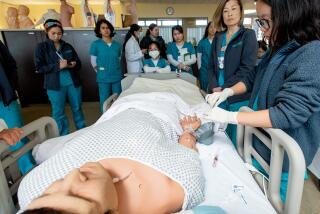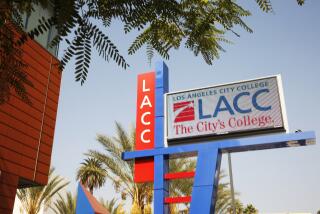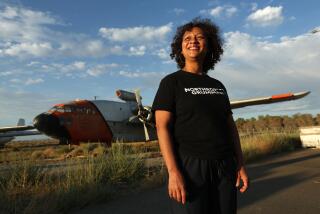Palomar College Nursing Students Gain the Prescription for Success
- Share via
SAN DIEGO — The current crop of student nurses at Palomar Community College say the pressure is on.
Their 30 counterparts of a year ago made up the only class of student nurses in San Diego County--out of the six student nursing programs offered here--that had a 100% pass rate in last summer’s national licensing examination. Passage of the exam gains the student the title of registered nurse.
Only four other nursing programs in California, out of 93, and only 114 other programs in the United States, out of 1,418, can boast that 100% of their students passed the nursing board exam in July. The test results were released recently by a consulting firm that statistically analyzes them on behalf of nursing schools, colleges and universities that are curious to know how they fared against others in the nation.
On the flip side of such success stories is the fact that 16% of the first-time students nationwide who took the test failed to pass it; among California students, the failure rate was about 9%.
The 100% pass rate does not necessarily suggest that Palomar’s nurse-training program is the best in San Diego County--but the teachers, students and alumni of the San Marcos school like to think so.
Gail Loofbourrow, the nurse manager of the oncology unit at Palomar Medical Center in Escondido--and herself a Palomar nursing school graduate--sings the school’s praises.
“I’ll hire any Palomar graduate I can,” she said. “And not just because of their test scores. You can have the knowledge, but that doesn’t mean you can implement that knowledge at the bedside. Palomar grads know how to use their knowledge.”
The teachers, students and alumni from Palomar have difficulty pinpointing the strength of their associate in arts degree program, which takes two years of nursing classes to complete and follows an initial year, or two, of prerequisite classes, including life science courses in chemistry, microbiology, anatomy and physiology.
Some credit the program’s success to the longevity of the faculty members, some of whom have been teaching on the San Marcos campus for more than 10 years, and their interaction with and encouragement of students.
Others suggest that it is Palomar’s well-rounded curriculum--developed by the faculty itself--and its balance of both textbook education and clinical, bedside studies, with a focus on the latest advances in nursing technology and methodology--that has best prepared students for the medical profession.
Some give credit to the students themselves, who say they put their lives on hold for three years or longer in order to study and work as student nurses en route to their nursing careers.
In any event, student nurses now at Palomar say they will accept the challenge to again bring kudos to the college, and to their profession.
Their reasons are old-fashioned.
“I’m in this for the personal satisfaction of helping other people. It sounds corny, but it’s true,” said Marybeth Barber, whose cheerleading attitude toward nursing makes her a spokeswoman of sorts for her classmates.
Added Barbara Ang, another student: “We’re certainly not in this for the money. We could do better if we went into something like engineering.”
Quipped student Helen Davis, in good spirit, “Plus, I like working nights and weekends.”
These students, and their peers throughout the nation, will probably have little difficulty finding jobs, since more women today are finding acceptance in professions outside of nursing, resulting in a nationwide shortage of hospital nurses.
The test for today’s nursing student, they say, will be in playing the role of a 1990s nurse, who will have greater responsibility--and exposure to liabilities--than what might have been expected of nurses who entered the field only 10 years ago:
* More often, nurses and doctors collaborate in assessing a patient’s condition and planning his care, and doctors more regularly rely on a nurse’s observation and evaluation of a patient’s changing condition.
* Today’s nurse must have the technical know-how to monitor and operate sophisticated medical equipment.
* She (male nurses are still the exception) must be familiar with a growing number of drugs and medications, and is personally liable if she administers a drug that might cause a dangerous reaction in a patient, even if the doctor prescribed it.
* She has greater freedom and flexibility in deciding how to promote a patient’s physical comfort--deciding, for instance, what kind of therapy or aid should should be given to an asthma patient.
* She plays a greater role as patient educator, giving home-care advice to people who are finding their hospital stays shorter and are going home sooner to finish their mending.
* And she no longer plays only the traditional roles of mother, counselor, “gofer,” social worker, psychologist, friend and scapegoat, but must also deal with social issues that were uncommon even a decade ago and on which she must stifle her own opinions or biases. These issues can include AIDS or a family decision not to use extraordinary means to keep a terminally ill patient alive.
Palomar College’s nursing program is 22 years old and currently has 130 students enrolled--with another 90 taking pre-nursing classes. Students are in the classroom two days a week, 5 1/2 hours a day, and another two to three hours in the college’s laboratory, which is equipped with hospital beds, mannequins and other props to give the look of a hospital ward. An additional 10 to 14 hours weekly are spent at an area hospital for student nursing tasks.
Irene Stiller, chairman of Palomar’s nursing department, said today’s student has a harder task than her predecessors.
“There are tons more information to learn than before, and more responsibility is being delegated to nurses than ever,” she said.
Stiller’s goal is to graduate students who do not need to rely on rote memory of answers and procedures, but who are competent in “problem solving and intervening” as a medical practitioner.
Sylvia Tatman, one of 10 full-time faculty members at Palomar, agreed.
“Nurses today are being asked to be more creative, and are thinking about why they are doing what they’re doing,” she said. “They are showing more critical thinking, more decision making, more problem-solving skills.
“Nurses today, for instance, are taking their own data and making decisions based on that. If a patient is on a respirator, the nurse is gathering information about blood gases and, through that, adjusting the respirator according to that patient.”
Stiller, Tatman and other faculty members characterize what they teach as the “nursing process,” which calls for the nurse herself to set goals for the patient’s improvement, and to map out what tasks she needs to accomplish for the patient to reach that goal.
“It used to be that the nurse was reacting to the doctor,” Tatman said. “Today’s nurse is ‘pro-active.’ ”
More to Read
Sign up for Essential California
The most important California stories and recommendations in your inbox every morning.
You may occasionally receive promotional content from the Los Angeles Times.










